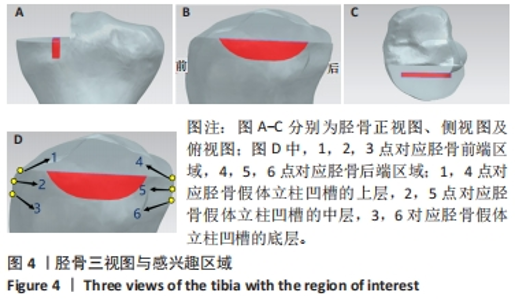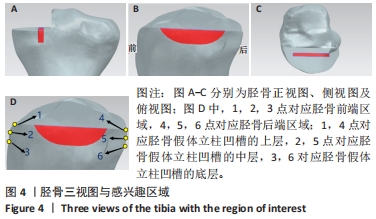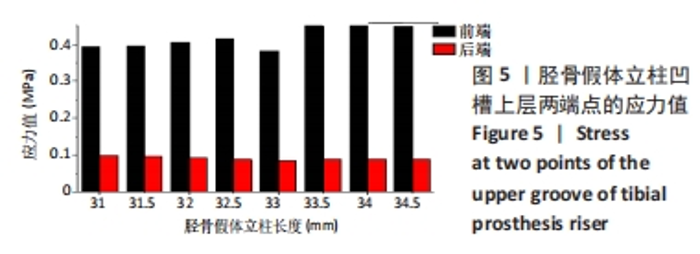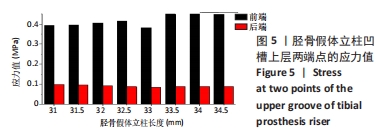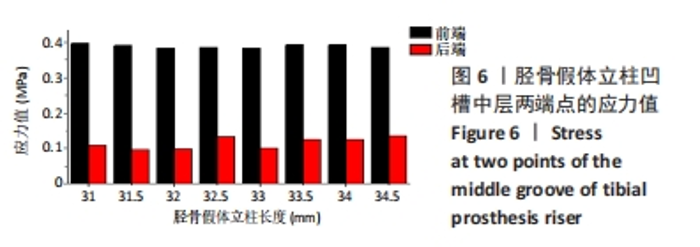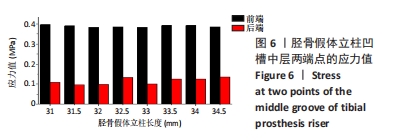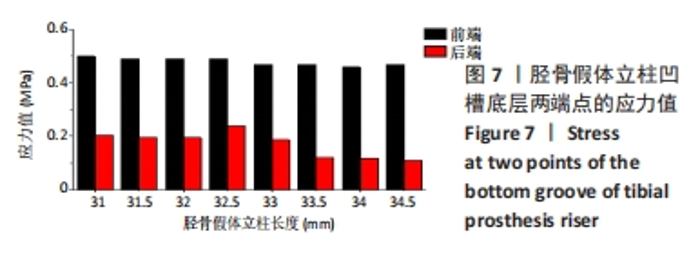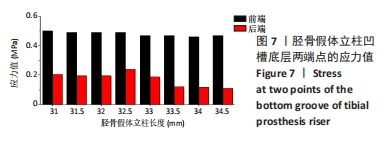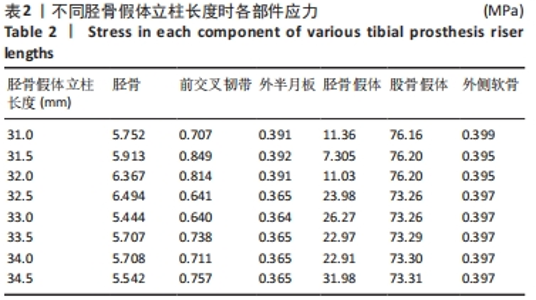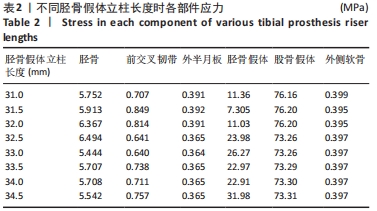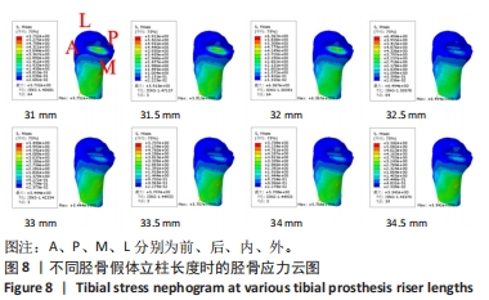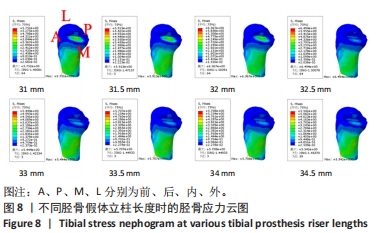Chinese Journal of Tissue Engineering Research ›› 2024, Vol. 28 ›› Issue (21): 3281-3285.doi: 10.12307/2024.086
Effect of tibial prosthesis riser length on knee biomechanics after unicompartmental knee arthroplasty
Zhang Kai1, Zhao Mingxin2, Yang Yuzhu2, Guo Yuan2, Ji Binping1
- 1Shanxi Huajin Orthopaedic Hospital, Taiyuan 030400, Shanxi Province, China; 2College of Biomedical Engineering, Taiyuan University of Technology, Jinzhong 030600, Shanxi Province, China
-
Received:2023-04-04Accepted:2023-06-08Online:2024-07-28Published:2023-09-27 -
Contact:Ji Binping, MD, Chief physician, Shanxi Huajin Orthopaedic Hospital, Taiyuan 030400, Shanxi Province, China -
About author:Zhang Kai, Associate chief physician, Shanxi Huajin Orthopaedic Hospital, Taiyuan 030400, Shanxi Province, China -
Supported by:National Natural Science Foundation of China (General Program), No. 11772214 (to GY)
CLC Number:
Cite this article
Zhang Kai, Zhao Mingxin, Yang Yuzhu, Guo Yuan, Ji Binping. Effect of tibial prosthesis riser length on knee biomechanics after unicompartmental knee arthroplasty[J]. Chinese Journal of Tissue Engineering Research, 2024, 28(21): 3281-3285.
share this article
Add to citation manager EndNote|Reference Manager|ProCite|BibTeX|RefWorks
| [1] 涂意辉. 外侧单髁置换术:挑战与希望并存[J]. 中华外科杂志,2020,58(9):687-690. [2] LUSTIG S, LORDING T, FRANK F, et al. Progression of medial osteoarthritis and long term results of lateral unicompartmental arthroplasty: 10 to 18 year follow-up of 54 consecutive implants. Knee. 2014;21 Suppl 1:S26-S32. [3] MURRAY DW, GOODFELLOW JW, O’CONNOR JJ. The Oxford medial unicompartmental arthroplasty: a ten-year survival study. J Bone Joint Surg Br. 1998;80(6):983-989. [4] CHRISTENSEN NO. Unicompartmental prosthesis for gonarthrosis. A nine-year series of 575 knees from a Swedish hospital. Clin Orthop Relat Res. 1991; (273):165-169. [5] GILL JR, CORBETT JA, WASTNEDGE E, et al. Forgotten Joint Score: Comparison between total and unicompartment knee arthroplasty. Knee. 2021;29:26-32. [6] HALAWI MJ, BARSOUM WK. Unicompartment knee arthroplasty: Key concepts. J Clin Orthop Trauma. 2017;8(1):11-13. [7] PEERSMAN G, JAK W, VANDENLANGENBERGH T, et al. Cost-effectiveness of unicondylar versus total knee arthroplasty: a Markov model analysis. Knee. 2014; 21 Suppl 1:S37-S42. [8] 贾笛, 李彦林, 杨龄坚, 等. 单髁置换术后膝关节内外侧间室应力变化有限元分析[J]. 中国运动医学杂志,2017,36(10):852-857. [9] LASKIN RS. Unicompartmental tibiofemoral resurfacing arthroplasty. J Bone Joint Surg Am. 1978;60(2):182-185. [10] NEWMAN JH, ACKROYD CE, SHAH NA. Unicompartmental or total knee replacement? Five-year results of a prospective, randomised trial of 102 osteoarthritic knees with unicompartmental arthritis. J Bone Joint Surg Br. 1998; 80(5):862-865. [11] TAYLOR M, BRYAN R, GALLOWAY F. Accounting for patient variability in finite element analysis of the intact and implanted hip and knee: a review. Int J Numer Method Biomed Eng. 2013;29(2):273-292. [12] KANG KT, KWON OR, SON J, et al. Effect of joint line preservation on mobile-type bearing unicompartmental knee arthroplasty: finite element analysis. Australas Phys Eng Sci Med. 2018;41(1):201-208. [13] 朱广铎. 单髁膝关节置换有限元分析[D].北京:北京协和医学院,2016. [14] KANG KT, SON J, KWON SK, et al. Preservation of femoral and tibial coronal alignment to improve biomechanical effects of medial unicompartment knee arthroplasty: Computational study. Biomed Mater Eng. 2018;29(5):651-664. [15] GALBUSERA F, FREUTEL M, DÜRSELEN L, et al. Material models and properties in the finite element analysis of knee ligaments: a literature review. Front Bioeng Biotechnol. 2014;2:54. [16] ZHU GD, GUO WS, ZHANG QD, et al. Finite Element Analysis of Mobile-bearing Unicompartmental Knee Arthroplasty: The Influence of Tibial Component Coronal Alignment. Chin Med J (Engl). 2015;128(21):2873-2878. [17] BAO HR, ZHU D, GONG H, et al. The effect of complete radial lateral meniscus posterior root tear on the knee contact mechanics: a finite element analysis. J Orthop Sci. 2013;18(2):256-263. [18] RHO JY, HOBATHO MC, ASHMAN RB. Relations of mechanical properties to density and CT numbers in human bone. Med Eng Phys. 1995;17(5):347-355. [19] 张国栋,廖维靖,陶圣祥,等. 股骨有限元分析赋材料属性的方法[J]. 中国组织工程研究与临床康复,2009,13(43): 8436-8441. [20] 卢明峰,钟露斌,李泽晖,等. 牛津单髁置换术与全膝关节置换术治疗膝内侧单间室骨关节炎的近期疗效对比研究[J]. 中华骨与关节外科杂志,2016, 9(6):476-479,503. [21] 胡懿郃,王贤,廖前德,等. 单髁膝关节置换治疗膝关节单间室病变[J]. 中国矫形外科杂志,2008,16(3):161-163. [22] COSSEY AJ, SPRIGGINS AJ. The use of computer-assisted surgical navigation to prevent malalignment in unicompartmental knee arthroplasty. J Arthroplasty. 2005;20(1):29-34. [23] 崔文,杨抒,张小刚,等. 国内全膝关节置换磨损测试及数值模拟研究进展[J]. 中华骨科杂志,2021,41(7):459-470. [24] KOH YG, PARK KM, KANG K, et al. Finite element analysis of the influence of the posterior tibial slope on mobile-bearing unicompartmental knee arthroplasty. Knee. 2021;29:116-125. [25] 坤能,赵改平,刘冬青,等.膝关节单髁置换术胫骨假体不同后倾角对假体磨损和功能的影响[J].医用生物力学,2021,36(4):618-624. [26] PEGG EC, WALTER J, MELLON SJ, et al. Evaluation of factors affecting tibial bone strain after unicompartmental knee replacement. J Orthop Res. 2013;31(5):821-828. [27] THOREAU L, MORCILLO MARFIL D, THIENPONT E. Correction to: Periprosthetic fractures after medial unicompartmental knee arthroplasty: a narrative review. Arch Orthop Trauma Surg. 2022;142(8):2049. [28] 王煜东,汪利合,孙明帅,等.单髁置换术后假体周围骨折的危险因素及防治措施的研究进展[J].实用临床医药杂志,2022,26(14):144-148. [29] HOUSKAMP DJ, TOMPANE T, BARLOW BT. What Is the Critical Tibial Resection Depth During Unicompartmental Knee Arthroplasty? A Biomechanical Study of Fracture Risk. J Arthroplasty. 2020;35(8):2244-2248. [30] BURGER JA, JAGER T, DOOLEY MS, et al. Comparable incidence of periprosthetic tibial fractures in cementless and cemented unicompartmental knee arthroplasty: a systematic review and meta-analysis. Knee Surg Sports Traumatol Arthrosc. 2022;30(3):852-874. [31] ALETO TJ, BEREND ME, RITTER MA, et al. Early failure of unicompartmental knee arthroplasty leading to revision. J Arthroplasty. 2008;23(2):159-163. [32] MOHAMMAD HR, MATHARU GS, JUDGE A, et al. New surgical instrumentation reduces the revision rate of unicompartmental knee replacement: A propensity score matched comparison of 15,906 knees from the National Joint Registry. Knee. 2020;27(3):993-1002. [33] HIRANAKA T, YOSHIKAWA R, YOSHIDA K, et al. Tibial shape and size predicts the risk of tibial plateau fracture after cementless unicompartmental knee arthroplasty in Japanese patients. Bone Joint J. 2020;102-B(7):861-867. [34] SMALL SR, BEREND ME, RITTER MA, et al. Bearing mobility affects tibial strain in mobile-bearing unicompartmental knee arthroplasty. Surg Technol Int. 2010; 19:185-190. [35] PRICE AJ, SVARD U. A second decade lifetable survival analysis of the Oxford unicompartmental knee arthroplasty. Clin Orthop Relat Res. 2011;469(1):174-179. [36] WALKER T, HETTO P, BRUCKNER T, et al. Minimally invasive Oxford unicompartmental knee arthroplasty ensures excellent functional outcome and high survivorship in the long term. Knee Surg Sports Traumatol Arthrosc. 2019;27(5):1658-1664. [37] PEGG EC, WALTER J, MELLON SJ, et al. Evaluation of factors affecting tibial bone strain after unicompartmental knee replacement. J Orthop Res. 2013;31(5):821-828. [38] SEEGER JB, HAAS D, JÄGER S, et al. Extended sagittal saw cut significantly reduces fracture load in cementless unicompartmental knee arthroplasty compared to cemented tibia plateaus: an experimental cadaver study. Knee Surg Sports Traumatol Arthrosc. 2012;20(6):1087-1091. |
| [1] | Li Zhifei, Yang Yin, Chen Hualong, Liang Qinqiu, Zhong Yuanming, Zhang Yisheng. Finite element analysis of the correlation between tilt angle of titanium cage and postoperative subsidence of titanium cage after anterior subtotal cervical corpectomy, decompression and fusion [J]. Chinese Journal of Tissue Engineering Research, 2024, 28(9): 1313-1319. |
| [2] | Liang Cheng, Zhang Linqi, Wang Guan, Li Wen, Duan Ke, Li Zhong, Lu Xiaobo, Zhuo Naiqiang. Finite element and biomechanical analysis of different implants in repair for unilateral unstable pelvic posterior ring injury [J]. Chinese Journal of Tissue Engineering Research, 2024, 28(9): 1336-1341. |
| [3] | Yang Junliang, Lu Tan, Xu Biao, Jiang Yaqiong, Wang Fucheng. Three-dimensional finite element analysis of effects of partial anterior cruciate ligament rupture on knee joint stress [J]. Chinese Journal of Tissue Engineering Research, 2024, 28(9): 1347-1353. |
| [4] | Li Yongjie, Fu Shenyu, Xia Yuan, Zhang Dakuan, Liu Hongju. Correlation of knee extensor muscle strength and spatiotemporal gait parameters with peak knee flexion/adduction moment in female patients with knee osteoarthritis [J]. Chinese Journal of Tissue Engineering Research, 2024, 28(9): 1354-1358. |
| [5] | Du Changling, Shi Hui, Zhang Shoutao, Meng Tao, Liu Dong, Li Jian, Cao Heng, Xu Chuang. Efficacy and safety of different applications of tranexamic acid in high tibial osteotomy [J]. Chinese Journal of Tissue Engineering Research, 2024, 28(9): 1409-1413. |
| [6] | Huang Xiarong, Hu Lizhi, Sun Guanghua, Peng Xinke, Liao Ying, Liao Yuan, Liu Jing, Yin Linwei, Zhong Peirui, Peng Ting, Zhou Jun, Qu Mengjian. Effect of electroacupuncture on the expression of P53 and P21 in articular cartilage and subchondral bone of aged rats with knee osteoarthritis [J]. Chinese Journal of Tissue Engineering Research, 2024, 28(8): 1174-1179. |
| [7] | Xiaheida·Yilaerjiang, Nijiati·Tuerxun, Reyila·Kuerban, Baibujiafu·Yelisi, Chen Xin. Three-dimensional finite element analysis of the distribution pattern of stress in bone tissues with different characteristics [J]. Chinese Journal of Tissue Engineering Research, 2024, 28(8): 1277-1282. |
| [8] | Wang Qiang, Li Shiyun, Xiong Ying, Li Tiantian. Biomechanical changes of the cervical spine in internal fixation with different anterior cervical interbody fusion systems [J]. Chinese Journal of Tissue Engineering Research, 2024, 28(6): 821-826. |
| [9] | Wei Yuanbiao, Lin Zhan, Chen Yanmei, Yang Tenghui, Zhao Xiao, Chen Yangsheng, Zhou Yanhui, Yang Minchao, Huang Feiqi. Finite element analysis of effects of sagittal cervical manipulation on intervertebral disc and facet joints [J]. Chinese Journal of Tissue Engineering Research, 2024, 28(6): 827-832. |
| [10] | Zhang Rui, Wang Kun, Shen Zicong, Mao Lu, Wu Xiaotao. Effects of endoscopic foraminoplasty and laminoplasty on biomechanical properties of intervertebral disc and isthmus [J]. Chinese Journal of Tissue Engineering Research, 2024, 28(6): 833-839. |
| [11] | Kang Zhijie, Cao Zhenhua, Xu Yangyang, Zhang Yunfeng, Jin Feng, Su Baoke, Wang Lidong, Tong Ling, Liu Qinghua, Fang Yuan, Sha Lirong, Liang Liang, Li Mengmeng, Du Yifei, Lin Lin, Wang Haiyan, Li Xiaohe, Li Zhijun. Finite element model establishment and stress analysis of lumbar-sacral intervertebral disc in ankylosing spondylitis [J]. Chinese Journal of Tissue Engineering Research, 2024, 28(6): 840-846. |
| [12] | Huang Peizhen, Dong Hang, Cai Qunbin, Lin Ziling, Huang Feng. Finite element analysis of anterograde and retrograde intramedullary nail for different areas of femoral shaft fractures [J]. Chinese Journal of Tissue Engineering Research, 2024, 28(6): 868-872. |
| [13] | Wang Mingming, Zhang Zhong, Sun Jianhua, Zhao Gang, Song Hua, Yan Huadong, Lyu Bin. Finite element analysis of three different minimally invasive fixation methods for distal tibial fractures with soft tissue injury [J]. Chinese Journal of Tissue Engineering Research, 2024, 28(6): 879-885. |
| [14] | Ning Tianliang, Wang Kun, Wang Lingbiao, Han Pengfei. Finite element analysis on correction effect of varus foot orthosis based on the three-point force principle [J]. Chinese Journal of Tissue Engineering Research, 2024, 28(6): 891-899. |
| [15] | Zhang Zeyi, Yang Yimin, Li Wenyan, Zhang Meizhen. Effect of foot progression angle on lower extremity kinetics of knee osteoarthritis patients of different ages: a systematic review and meta-analysis [J]. Chinese Journal of Tissue Engineering Research, 2024, 28(6): 968-975. |
| Viewed | ||||||
|
Full text |
|
|||||
|
Abstract |
|
|||||
